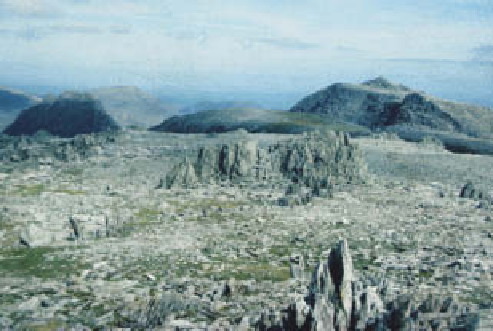Geoscience Reference
In-Depth Information
altiplanation terrace (background) frost-weathered across
steeply dipping tuffs and siltstones on Glyder Fach (94 m OD),
Snowdonia, North Wales.
Photo: Ken Addison
Progressive dissection of the rock wall forms an 'hourglass'
shape with chutes feeding cones, which coalesce as the
pinnacles are finally eroded (
Plate 24.12
).
Debris supply
to developing talus slopes can be relatively steady or
markedly episodic. Seasonal melt is a major influence
affecting their form and onward transfer processes. Most
rockfall and shallow slide debris enters the slope near the
rockwall foot and is then reworked by a combination of
slow, talus-wide processes involving creep, solifluction
and slope wash, and fast, more concentrated debris slide,
mudflows and snow/slush avalanches. Rapid movement
is common during spring melt, especially in the active
layer where permafrost is present, and intense summer
rainstorms after dry spells. Debris flows are the most
rapid means of reworking talus and usually originate at
the sharp break in slope angle and permeability at the
rockwall-talus boundary, below chutes (see box, p. 308).
Flowing at 5-15 m sec
-1
, they contrast markedly with
debris creep at 10-100 cm yr
-1
. Progressive incorporation
of glacial debris towards valley floors creates geotech-
nically complex colluvium. The profile of the mature
debris slope is usually concave, reducing from 35-43
at the rock-wall foot to 25-35
Holocene climates on Snowdon, North Wales.
Photo: Ken Addison
therefore mechanically unstable rock (see
Chapter 13).
Major rockslides usually occur as a result of catastrophic
destabilization along deep-seated failure surfaces
involving very large rock volumes, between 10
5
m
3
and
10
10
m
3
. They depend on postglacial unloading, as in the
1963 Vaiont slide in northern Italy (2·5
10
8
m
3
), or
seismo-tectonic activity such as the 1964 Sherman Glacier
slide, Alaska (2·3
10
7
m
3
). Frost weathering works
directly, sending small fragments into free fall, and
indirectly by widening discontinuities and weakening
joint fill. This increases susceptibility to unloading and
intense run-off. Unloading generates tension cracks in
upper rock walls, whereas intense run-off can operate
across their entire face. Stimulated by rainfall or melt
episodes, with power enhanced by high elevation and
steep slopes, it flushes out loose debris and may promote
rockslides. A combination of all three processes works the
rock wall into a series of chutes and intervening rock
pinnacles which can locally intensify any one of them.
Debris delivered to the rockwall foot accumulates
initially as an extensive apron or series of
talus cones
.
in mid-slope (the
approximate internal friction angle of granular debris)
and 0-5
at the foot. This reflects reworking according to
grain/block size, shape and degree of disturbance.
Alpine hydrology
Fluvial processes receive less attention in the alpine zone,
although rivers eventually shift most slope-derived
sediment, and yields from glaciated catchments are among











































